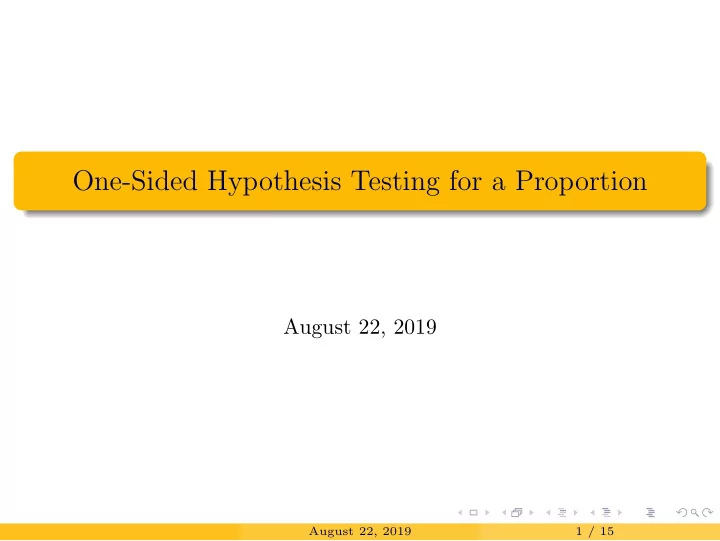

One-Sided Hypothesis Testing for a Proportion August 22, 2019 August 22, 2019 1 / 15
Choosing a Significance Level The standard significance level for most fields is α = 0 . 05 Sometimes we may adjust the significance level based on application. For example, if making a Type I error is especially problematic, we might reduce our significance level slightly. If making a Type II error is especially problematic, we might increase our significance level slightly. Collecting more data also reduces Type II error, so whenever reasonable it’s a good idea to collect more data! Sections 5.3 & 6.1 August 22, 2019 2 / 15
Statistical Significance vs Practical Significance For very large sample sizes, point estimates can become very precise. In these cases, differences between the point estimate and null value become easier to detect. Sometimes we can detect even an incredibly small difference! These differences are statistically significant, but may not be practically significant. Sections 5.3 & 6.1 August 22, 2019 3 / 15
Statistical Significance vs Practical Significance For example, An online experiment might identify that placing additional ads on a movie review website statistically significantly increases viewership of a TV show by 0.001%. But... who cares about an increase of 0.001%? This increase probably has no practical value. Sections 5.3 & 6.1 August 22, 2019 4 / 15
One-Sided Hypotheses So far we’ve considered only two-sided hypotheses : H 0 : p = p 0 H A : p � = p 0 Think of two-sided as when the alternative hypothesis has values on either side of the null proportion. Sections 5.3 & 6.1 August 22, 2019 5 / 15
One-Sided Hypotheses For a one-sided hypothesis test , the alternative hypothesis has values on only one side of the null proportion. Either H A : p > p 0 or H A : p < p 0 Sections 5.3 & 6.1 August 22, 2019 6 / 15
One-Sided Hypotheses We ALWAYS use equality in our null hypothesis! By convention, we write H 0 : p ≤ p 0 H A : p > p 0 or H 0 : p ≥ p 0 H A : p < p 0 Sections 5.3 & 6.1 August 22, 2019 7 / 15
One-Sided Hypothesis Testing There is only one major difference in one-sided hypothesis testing. For the test statistic approach We use the critical value z α instead of z α/ 2 . For the p-value approach We no longer multiply by two: p-value = P ( | Z | > | ts | ) Sections 5.3 & 6.1 August 22, 2019 8 / 15
One-Sided Hypothesis Testing In both cases, We are no longer interested in seeing observations as extreme as ˆ p . Now we are actively interested in a particular direction corresponding to the direction of the alternative hypothesis. This means that we are interested in a particular Z-score or a single tail area. Sections 5.3 & 6.1 August 22, 2019 9 / 15
One-Sided Hypothesis Testing This is useful for several reasons 1 We don’t have to find z α/ 2 or double the p-value, so the level of evidence required to reject H 0 goes down. 2 Sometimes we are really only interested in one direction. On the flip side, we lose the ability to detect any interesting findings in the opposite direction. Sections 5.3 & 6.1 August 22, 2019 10 / 15
Example In our first lecture, we talked through an example where doctors were interested in determining whether stents would help people who had a high risk of stroke. The researchers believed the stents would help. The data suggested the opposite, that stents were actively harmful. A one-sided test could have checked whether the stents were helpful, but a two-sided test allowed the researchers to see that there was harm being done. Sections 5.3 & 6.1 August 22, 2019 11 / 15
One-Sided Hypotheses Using one-sided hypotheses runs the risk of overlooking data supporting an opposite conclusion. We might have made the same error had we run a one-sided test on the world health question data. We probably would have been tempted to test H 0 : p ≤ 0 . 333 H A : p > 0 . 333 to see if people were better than chance. ...and we would have missed the finding that people actually do worse than chance levels! Sections 5.3 & 6.1 August 22, 2019 12 / 15
One-Sided Hypothesis Tests So when should you use a one-sided test? Rarely! Before using a one-sided test, consider What would we conclude if the data happens to go clearly in the opposite direction? Is there any value in learning about the data doing in the opposite direction? If there is any value in this, use a two-sided test! Sections 5.3 & 6.1 August 22, 2019 13 / 15
Why Can’t We Look at the Data First? We should always always always always set up our hypotheses and analysis plan before taking any data ! This is part of doing good science! If we pick hypotheses after seeing the data, If ˆ p < p 0 , and we set H A : p < p 0 , any observation in the lower 5% of the null distribution would lead to us rejecting H 0 . If ˆ p > p 0 , and we set H A : p < p 0 , any observation in the upper 5% of the null distribution would lead to us rejecting H 0 . Under H 0 , we now have a 0 . 05 + 0 . 05 = 0 . 1 probability of Type I error! Sections 5.3 & 6.1 August 22, 2019 14 / 15
A Note About Textbook Sections We’ve covered everything in section 6.1 Sections 5.3 & 6.1 August 22, 2019 15 / 15
Recommend
More recommend